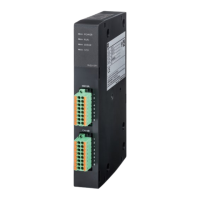4. Mounting Procedure
1. Cut the hole cover on the cover on the right
side of the amplifier unit with nippers, etc. to
expose the connector. When cutting, take
care not to scratch the board.
2. Align the 2 protrusions on the option with the
holes on the right side of the amplifier unit,
and secure temporarily so that the front
surface is flush.
3. Tighten screws (1) to (4) with a driver.
4. Tighten the provided screw (5) with a driver.
Tightening torque : 0.7 N・m
5. Maintenance and Inspection
Carry out daily and periodic inspection to prevent failures beforehand, and to ensure continued high-reliability operation.
Lengthy use of the product without inspection could result in failure and damage, or accident and fire.
■ Daily inspection
Conduct a visual check during operation to verify whether there are any abnormalities. Normally, the following inspections
should be carried out.
1) Has a significant amount of dust accumulated on the servo amplifier?
2) Does the ambient environment (temperature, power supply, etc.) satisfy the specifications?
3) Are there any LED display abnormalities?
4) Are there any abnormal noises, abnormal vibrations, or abnormal odors?
5) Are there any abnormalities such as signs of overheating or discoloration?
■ Periodic inspection
Carry out periodic inspection after stopping operation and turning OFF the power. It takes time for the main circuit DC part
smoothing capacitor to dissipate even after turning OFF the power. Always carry out inspection after ensuring that the
charge LED is OFF. A periodic inspection cycle of 1 year is recommended, however, the cycle may be shorted depending on
the usage conditions.
● Check the ambient temperature, humidity, vibration, and
atmosphere (presence of dust, gas, oil mist, water
droplets, etc.)
● Have any foreign objects such as tools, or dangerous
objects been left in the surrounding area?
● Perform a visual check,
and perform
measurement with the
respective meters.
● Perform a visual check.
● The specifications
should be satisfied.
● There should be no
objects lying around.
● Is the interface power supply voltage normal?
● Perform measurement
with a tester, etc.
● The specifications
should be satisfied.
● Is the display difficult to see? Does it light up correctly?
● Perform a visual check.
● There should be no
abnormalities.
● Is there any fixing screw looseness?
● Is there any damage?
● Is there any looseness or wire disconnection at crimped
parts?
● Tighten further.
● Perform a visual check.
● There should be no
abnormalities.
● Are the internal safety circuits functioning properly?
CAUTION : Safety standards stipulate that inspection is
required every 3 months.
● Turn the power ON
again.
● Turn the input terminals
ON and OFF.

